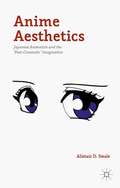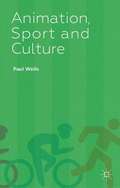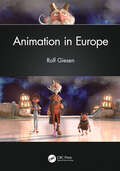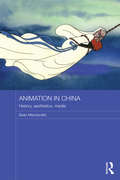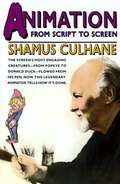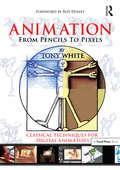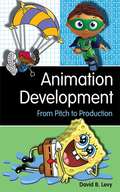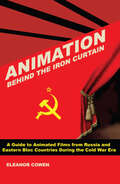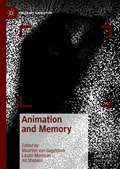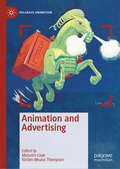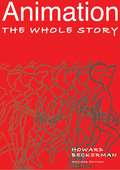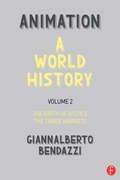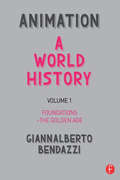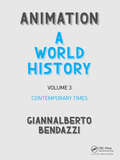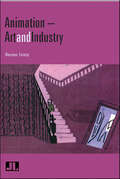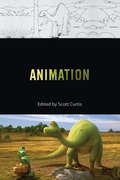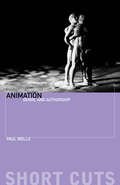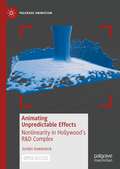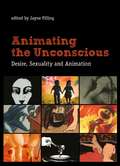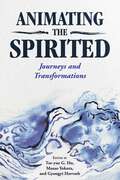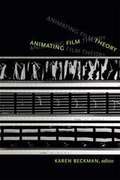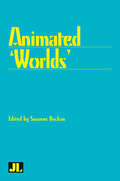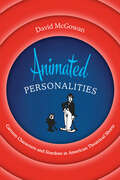- Table View
- List View
Anime Classics Zettai!
by Brian Camp Julie DavisFrom Stone Bridge Press, award-winning publishers of The Anime Encyclopedia, Hayao Miyazaki, and The Astro Boy Essays, comes a must-have guide to 100 essential Japanese animation films, TV series, and made-for-video series, from 1950s classics to the latest Cartoon Network hits.Looking for something specific? Eight unique icons make reviews easy to browse. From Akira to Naruto, Pokemon to Sailor Moon, here are summaries, style notes, rare facts, viewer-discretion guides, and critical comments on films that fans absolutely-zettai!-must see. Note: due to rights restrictions the ebook edition does not include images that are in the print edition.Julie Davis is the former editor-in-chief of Animerica: Anime & Manga Monthly. A writer and editor in San Francisco, Davis has translated manga for Viz (now Viz Media) and has contributed to Otaku USA and Manga: The Complete Guide.Brian Camp, program manager at CUNY-TV in New York, was a regular contributor to Animerica: Anime & Manga Monthly, and has taught a course on anime at New York's School of Visual Arts. Camp has also contributed to Animation World, Film Library Quarterly, the Motion Picture Guide, and the New York Daily News.
Anime Aesthetics: Japanese Animation And The 'post-cinematic' Imagination (New Security Challenges)
by Alistair D. SwaleJapanese animation has been given fulsome academic commentary in recent years. However, there is arguably a need for a more philosophically consistent and theoretically integrated engagement. While this book covers the key thinkers of contemporary aesthetic theory, it aims to reground reflection on anime within the aesthetics of R.G. Collingwood.
Animation, Sport and Culture
by Paul WellsAnimation, Sport and Culture is a wide-ranging study of both sport and animated films. From Goofy to Goalkeepers, Wallace and Gromit to Tiger Woods, Mickey Mouse to Messi, and Nike to Nationhood, this Olympic-sized analysis looks at the history, politics, aesthetics and technologies of sport and animation from around the globe.
Animation in Europe
by Rolf GiesenThere is a lot one could say about animation in Europe, but above all, there is no consistent European animation. It is as disparate as the various countries involved. Audiences will certainly recognize American or Japanese animation, but in Europe, it can range from Czech, Polish, and Hungarian to Greek, Italian, Spanish, Portuguese, French, and British. Animation in Europe provides a comprehensive review of the history and current situation of animation in over 20 European countries. It features numerous interviews with artists and producers, including rare documents and firsthand accounts that illustrate the rich history of animation in Europe. Additional features include • An extensive chronology with key events in European animation • A Who’s Who of producers, directors, writers, and animators working in Europe • An examination of the origin of European animation and its influence Animation in Europe is the first book devoted entirely to this topic and, therefore, will be of value for animation buffs as well as practitioners and researchers.
Animation in China: History, Aesthetics, Media (Routledge Contemporary China Series)
by Sean MacdonaldBy the turn of the 21st century, animation production has grown to thousands of hours a year in the People’s Republic of China (PRC). Despite this, and unlike American blockbuster productions and the diverse genres of Japanese anime, much animation from the PRC remains relatively unknown. This book is an historical and theoretical study of animation in the PRC. Although the Wan Brothers produced the first feature length animated film in 1941, the industry as we know it today truly began in the 1950s at the Shanghai Animation Film Studio (SAFS), which remained the sole animation studio until the 1980s. Considering animation in China as a convergence of the institutions of education, fine arts, literature, popular culture, and film, the book takes comparative approaches that link SAFS animation to contemporary cultural production including American and Japanese animation, Pop Art, and mass media theory. Through readings of classic films such as Princess Iron Fan, Uproar in Heaven, Princess Peacock, and Nezha Conquers the Dragon King, this study represents a revisionist history of animation in the PRC as a form of "postmodernism with Chinese characteristics." As a theoretical exploration of animation in the People’s Republic of China, this book will appeal greatly to students and scholars of animation, film studies, Chinese studies, cultural studies, political and cultural theory.
Animation from Script to Screen
by Shamus CulhaneShamus Culhane, the animator who made the dwarfs in Snow White, achieves something few are able to: He makes it possible to learn a concrete skill from a book. Covering every aspect of film animation, from basic mechanics to giving creativity full play, and including writing, recording, acting, dialogue-even how to mange an animation studio of one's own, Culhane fulfills the promise of his title-"from script to screen."
Animation from Pencils to Pixels: Classical Techniques for the Digital Animator (Animation Foundation Bundle Ser.)
by Tony WhiteJust add talent!Award-winning animator Tony White brings you the ultimate book for digital animation. Here you will find the classic knowledge of many legendary techniques revealed, paired with information relevant to today's capable, state-of-the-art technologies.White leaves nothing out. What contemporary digital animators most need to know can be found between this book's covers - from conceptions to creation and through the many stages of the production pipeline to distribution. This book is intended to serve as your one-stop how-to animation guide. Whether you're new to animation or a very experienced digital animator, here you'll find fundamentals, key classical techniques, and professional advice that will strengthen your work and well-roundedness as an animator.Speaking from experience, White presents time-honored secrets of professional animaton with a warm, masterly, and knowledgeable approach that has evolved from over 30 years as an award-winning animator/director.The book's enclosed downloadable resources presents classic moments from animation's history through White's personal homage to traditional drawn animation, "Endangered Species." Using movie clips and still images from the film, White shares the 'making of' journal of the film, detailing each step, with scene-by-scene descriptions, technique by technique. Look for the repetitive stress disorder guide on the downloadable resources, called, "Mega-hurts." Watch the many movie clips for insights into the versatility that a traditional, pencil-drawn approach to animaton can offer.
Animation Development: From Pitch to Production
by David B. LevyWhether a novice curious about the cartoon production process, a visual arts student who has not yet experienced that big break, or a seasoned professional looking for valuable insight, Animation Development is the go-to guide for creating the perfect pitch. David Levy has been through every aspect of the pitching process--preparation, hope, rejection, success- and now he wraps up his valuable experience to deliver this comprehensive guide on the industry and process. Animation Development will help readers discover how to tap into their creativity to develop something personal yet universal, push projects through collaborations and partnerships, set up pitch meetings, get legal representation and agents, and manage the emotional roller-coaster common to the pitching and development process.
Animation Behind the Iron Curtain
by Eleanor CowenAnimation Behind the Iron Curtain is a journey of discovery into the world of Soviet era animation from Eastern Bloc countries. From Jerzy Kucia's brutally exquisite Reflections in Poland to the sci-fi adventure of Ott in Space by Estonian puppet master Elbert Tuganov to the endearing Gopo's little man by Ion Popescu-Gopo in Romania, this excursion into Soviet era animation brings to light magnificent art, ruminations on the human condition, and celebrations of innocence and joy.As art reveals the spirit of the times, animation art of Eastern Europe during the Cold War, funded by the Soviet states, allowed artists to create works illuminating to their experiences, hopes, and fears. The political ideology of the time ironically supported these artists while simultaneously suppressing more direct critiques of Soviet life. Politics shaped the world of these artists who then fashioned their realities into amazing works of animation. Their art is integral to the circumstances in which they lived, which is why this book combines the unlikely combination of world politics and animated cartoons.The phenomenal animated films shared in this book offer a glimpse into the culture and hearts of Soviet citizens who grew up with characters as familiar and beloved to them as Mickey Mouse and Bugs Bunny are to Americans. This book lays out the basic political dynamics of the Cold War and how those political tensions affected the animation industry in both the US and in the Eastern Bloc. And, for animation novices and enthusiasts alike, Animation Behind the Iron Curtain also offers breakout sections to explain many of the techniques and aesthetic considerations that go into this fascinating art form. This book is a must read for anyone interested in the Cold War era and really cool animated films!
Animation and Memory (Palgrave Animation)
by László Munteán Maarten Van Gageldonk Ali ShobeiriThis book examines the role of memory in animation, as well as the ways in which the medium of animation can function as a technology of remembering and forgetting. By doing so, it establishes a platform for the cross-fertilization between the burgeoning fields of animation studies and memory studies. By analyzing a wide range of different animation types, from stop motion to computer animation, and from cell animated cartoons to painted animation, this book explores the ways in which animation can function as a representational medium. The five parts of the book discuss the interrelation of animation and memory through the lens of materiality, corporeality, animation techniques, the city, and animated documentaries. These discussions raise a number of questions: how do animation films bring forth personal and collective pasts? What is the role of found footage, objects, and sound in the material and affective dimensions of animation? How does animation serve political ends? The essays in this volume offer answers to these questions through a wide variety of case studies and contexts. The book will appeal to both a broad academic and a more general readership with an interest in animation studies, memory studies, cultural studies, comparative visual arts, and media studies.
Animation and Advertising (Palgrave Animation)
by Malcolm Cook Kirsten Moana ThompsonThroughout its history, animation has been fundamentally shaped by its application to promotion and marketing, with animation playing a vital role in advertising history. In individual case study chapters this book addresses, among others, the role of promotion and advertising for anime, Disney, MTV, Lotte Reiniger, Pixar and George Pal, and highlights American, Indian, Japanese, and European examples. This collection reviews the history of famous animation studios and artists, and rediscovers overlooked ones. It situates animated advertising within the context of a diverse intermedial and multi-platform media environment, influenced by print, radio and digital practices, and expanding beyond cinema and television screens into the workplace, theme park, trade expo and urban environment. It reveals the part that animation has played in shaping our consumption of particular brands and commodities, and assesses the ways in which animated advertising has both changed and been changed by the technologies and media that supported it, including digital production and distribution in the present day. Challenging the traditional privileging of art or entertainment over commercial animation, Animation and Advertising establishes a new and rich field of research, and raises many new questions concerning particular animation and media histories, and our methods for researching them.
Animation: The Whole Story
by Howard BeckermanProfessional animator Howard Beckerman has drawn them all: Popeye, Heckle & Jeckle, even Mickey Mouse. In Animation, he offers a road map to the complex art of making an animated feature. Vivid sketches, screen shots, and step-by-step illustrations show how to make a drawing come to life, create storyboards, use form and color, develop a soundtrack, edit, and more. This new edition is also thoroughly updated to reflect the latest trends surrounding digital technology. Animation provides artists and aspiring filmmakers with everything they need to carve their niche in today's quickly evolving animation industry.
Animation: The Birth of a Style - The Three Markets
by Giannalberto BendazziA continuation of 1994's groundbreaking Cartoons, Giannalberto Bendazzi's Animation: A World History is the largest, deepest, most comprehensive text of its kind, based on the idea that animation is an art form that deserves its own place in scholarship. Bendazzi delves beyond just Disney, offering readers glimpses into the animation of Russia, Africa, Latin America, and other often-neglected areas and introducing over fifty previously undiscovered artists. Full of first-hand, never before investigated, and elsewhere unavailable information, Animation: A World History encompasses the history of animation production on every continent over the span of three centuries. Volume II delves into the decades following the Golden Age, an uncertain time when television series were overshadowing feature films, art was heavily influenced by the Cold War, and new technologies began to emerge that threatened the traditional methods of animation. Take part in the turmoil of the 1950s through 90s as American animation began to lose its momentum and the advent of television created a global interest in the art form. With a wealth of new research, hundreds of photographs and film stills, and an easy-to-navigate organization, this book is essential reading for all serious students of animation history.
Animation: Foundations - The Golden Age
by Giannalberto BendazziA continuation of 1994's groundbreaking Cartoons, Giannalberto Bendazzi's Animation: A World History is the largest, deepest, most comprehensive text of its kind, based on the idea that animation is an art form that deserves its own place in scholarship. Bendazzi delves beyond just Disney, offering readers glimpses into the animation of Russia, Africa, Latin America, and other often-neglected areas and introducing over fifty previously undiscovered artists. Full of first-hand, never before investigated, and elsewhere unavailable information, Animation: A World History encompasses the history of animation production on every continent over the span of three centuries. Volume I traces the roots and predecessors of modern animation, the history behind Émile Cohl's Fantasmagorie, and twenty years of silent animated films. Encompassing the formative years of the art form through its Golden Age, this book accounts for animation history through 1950 and covers everything from well-known classics like Steamboat Willie to animation in Egypt and Nazi Germany. With a wealth of new research, hundreds of photographs and film stills, and an easy-to-navigate organization, this book is essential reading for all serious students of animation history.
Animation: Contemporary Times
by Giannalberto BendazziA continuation of 1994's groundbreaking Cartoons, Giannalberto Bendazzi's Animation: A World History is the largest, deepest, most comprehensive text of its kind, based on the idea that animation is an art form that deserves its own place in scholarship. Bendazzi delves beyond just Disney, offering readers glimpses into the animation of Russia, Africa, Latin America, and other often-neglected areas and introducing over fifty previously undiscovered artists. Full of first-hand, never before investigated, and elsewhere unavailable information, Animation: A World History encompasses the history of animation production on every continent over the span of three centuries. Volume III catches you up to speed on the state of animation from 1991 to present. Although characterized by such trends as economic globalization, the expansion of television series, emerging markets in countries like China and India, and the consolidation of elitist auteur animation, the story of contemporary animation is still open to interpretation. With an abundance of first-hand research and topics ranging from Nickelodeon and Pixar to modern Estonian animation, this book is the most complete record of modern animation on the market and is essential reading for all serious students of animation history.
Animation: Art and Industry
by Maureen FurnissAnimation—Art and Industry is an introductory reader covering a broad range of animation studies topics, focusing on both American and international contexts. It provides information about key individuals in the fields of both independent and experimental animation, and introduces a variety of topics relevant to the critical study of media—censorship, representations of gender and race, and the relationship between popular culture and fine art. Essays span the silent era to the present, include new media such as web animation and gaming, and address animation made using a variety of techniques.
Animation (Behind the Silver Screen Series)
by Susan Ohmer Kevin Sandler Alla Gadassik Andrew Johnston Bob RehakFrom the earliest motion pictures and cartoons of the 1900s, to the latest 3D animated feature and CGI blockbuster, animation has always been a part of the cinematic experience. While the boundaries between animation and live-action have often been carefully tended, the ubiquity of contemporary computer imaging certainly blurs those lines, thereby confirming the importance of animation for the history of American cinema. The last installment of the acclaimed Behind the Silver Screen series, Animation explores the variety of technologies and modes of production throughout the history of American animation: the artisanal, solitary labors of early animators such as Winsor McCay, or of independent animators such as Mary Ellen Bute; the industrial assembly lines of Hollywood studio-unit animation; the parsimonious production houses of the post-studio, post-war era; the collaborative approach of boutique animation and special-effect houses. Drawing on archival sources, this volume provides not only an overview of American animation history, but also, by focusing on the relationship between production and style, a unique approach to understanding animation in general.
Animation: Genre and Authorship (Short Cuts)
by Paul WellsAnimation: Genre and Authorship explores the distinctive language of animation, its production processes, and the particular questions about who makes it, under what conditions, and with what purpose. In this first study to look specifically at the ways in which animation displays unique models of ‘auteurism’ and how it revises generic categories, Paul Wells challenges the prominence of live-action moviemaking as the first form of contemporary cinema and visual culture. The book also includes interviews with Ray Harryhausen and Caroline Leaf, and a full timeline of the history of animation.
Animating Unpredictable Effects: Nonlinearity in Hollywood’s R&D Complex (Palgrave Animation)
by Jordan GowanlockUncanny computer-generated animations of splashing waves, billowing smoke clouds, and characters’ flowing hair have become a ubiquitous presence on screens of all types since the 1980s. This Open Access book charts the history of these digital moving images and the software tools that make them. Unpredictable Visual Effects uncovers an institutional and industrial history that saw media industries conducting more private R&D as Cold War federal funding began to wane in the late 1980s. In this context studios and media software companies took concepts used for studying and managing unpredictable systems like markets, weather, and fluids and turned them into tools for animation. Unpredictable Visual Effects theorizes how these animations are part of a paradigm of control evident across society, while at the same time exploring what they can teach us about the relationship between making and knowing.
Animating the Unconscious: Desire, Sexuality and Animation
by Jayne PillingDetailed analysis of both the process and practice of key contemporary filmmakers, while also raising more general issues around the specificities of animation.
Animating the Unconscious: Desire, Sexuality, and Animation
by Pilling Jayne Ed.As critical interest has grown in the unique ways in which art animation explores and depicts subjective experience – particularly in relation to desire, sexuality, social constructions of gender, confessional modes, fantasy, and the animated documentary – this volume offers detailed analysis of both the process and practice of key contemporary filmmakers, while also raising more general issues around the specificities of animation. Combining critical essays with interview material, visual mapping of the creative process, consideration of the neglected issue of how the use of sound differs from that of conventional live-action, and filmmakers' critiques of each others' work, this unique collection aims to both provoke and illuminate via an insightful multi-faceted approach.
Animating the Spirited: Journeys and Transformations
by Tze-yue G. Hu, Masao Yokota and Gyongyi HorvathContributions by Graham Barton, Raz Greenberg, Gyongyi Horvath, Birgitta Hosea, Tze-yue G. Hu, Yin Ker, M. Javad Khajavi, Richard J. Leskosky, Yuk Lan Ng, Giryung Park, Eileen Anastasia Reynolds, Akiko Sugawa-Shimada, Koji Yamamura, Masao Yokota, and Millie Young Getting in touch with a spiritual side is a craving many are unable to express or voice, but readers and viewers seek out this desired connection to something greater through animation, cinema, anime, and art. Animating the Spirited: Journeys and Transformations includes a range of explorations of the meanings of the spirited and spiritual in the diverse, dynamic, and polarized creative environment of the twenty-first century. While animation is at the heart of the book, such related subjects as fine art, comics, children's literature, folklore, religion, and philosophy enrich the discoveries. These interdisciplinary discussions range from theory to practice, within the framework of an ever-changing media landscape. Working on different continents and coming from varying cultural backgrounds, these diverse scholars, artists, curators, and educators demonstrate the insights of the spirited. Authors also size up new dimensions of mental health and related expressions of human living and interactions. While the book recognizes and acknowledges the particularities of the spirited across cultures, it also highlights its universality, demonstrating how it is being studied, researched, comprehended, expressed, and consumed in various parts of the world.
Animating Film Theory
by Karen BeckmanAnimating Film Theory provides an enriched understanding of the relationship between two of the most unwieldy and unstable organizing concepts in cinema and media studies: animation and film theory. For the most part, animation has been excluded from the purview of film theory. The contributors to this collection consider the reasons for this marginalization while also bringing attention to key historical contributions across a wide range of animation practices, geographic and linguistic terrains, and historical periods. They delve deep into questions of how animation might best be understood, as well as how it relates to concepts such as the still, the moving image, the frame, animism, and utopia. The contributors take on the kinds of theoretical questions that have remained underexplored because, as Karen Beckman argues, scholars of cinema and media studies have allowed themselves to be constrained by too narrow a sense of what cinema is. This collection reanimates and expands film studies by taking the concept of animation seriously.Contributors. Karen Beckman, Suzanne Buchan, Scott Bukatman, Alan Cholodenko, Yuriko Furuhata, Alexander R. Galloway, Oliver Gaycken, Bishnupriya Ghosh, Tom Gunning, Andrew R. Johnston, Hervé Joubert-Laurencin, Gertrud Koch, Thomas LaMarre, Christopher P. Lehman, Esther Leslie, John MacKay, Mihaela Mihailova, Marc Steinberg, Tess Takahashi
Animated Worlds
by Suzanne BuchanWhat do we mean by the term "animation" when we are discussing film? Is it a technique? A style? A way of seeing or experiencing "a world" that has little relation to our own lived experience of "the world"? In Animated Worlds, contributors reveal the astonishing variety of "worlds" animation confronts us with. Essays range from close film analyses to phenomenological and cognitive approaches, spectatorship, performance, literary theory, and digital aesthetics. Authors include Vivian Sobchack, Richard Weihe, Thomas Lamarre, Paul Wells, and Karin Wehn.
Animated Personalities: Cartoon Characters and Stardom in American Theatrical Shorts
by David McGowanMickey Mouse, Betty Boop, Donald Duck, Bugs Bunny, Felix the Cat, and other beloved cartoon characters have entertained media audiences for almost a century, outliving the human stars who were once their contemporaries in studio-era Hollywood. In Animated Personalities, David McGowan asserts that iconic American theatrical short cartoon characters should be legitimately regarded as stars, equal to their live-action counterparts, not only because they have enjoyed long careers, but also because their star personas have been created and marketed in ways also used for cinematic celebrities.Drawing on detailed archival research, McGowan analyzes how Hollywood studios constructed and manipulated the star personas of the animated characters they owned. He shows how cartoon actors frequently kept pace with their human counterparts, granting “interviews,” allowing “candid” photographs, endorsing products, and generally behaving as actual actors did—for example, Donald Duck served his country during World War II, and Mickey Mouse was even embroiled in scandal. Challenging the notion that studios needed actors with physical bodies and real off-screen lives to create stars, McGowan demonstrates that media texts have successfully articulated an off-screen existence for animated characters. Following cartoon stars from silent movies to contemporary film and television, this groundbreaking book broadens the scope of star studies to include animation, concluding with provocative questions about the nature of stardom in an age of digitally enhanced filmmaking technologies.

